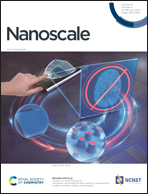Multimode adaptive logic gates based on temperature-responsive DNA strand displacement†
Abstract
Living organisms switch their intrinsic biological states to survive environmental turbulence, in which temperature changes are prevalent in nature. Most artificial temperature-responsive DNA nanosystems work as switch modules that transit between “ON–OFF” states, making it difficult to construct nanosystems with diverse functions. In this study, we present a general strategy to build multimode nanosystems based on a temperature-responsive DNA strand displacement reaction. The temperature-responsive DNA strand displacement was controlled by tuning the sequence of the substrate hairpin strands and the invading strands. The nanosystems were demonstrated as logic gates that performed a set of Boolean logical functions at specific temperatures. In addition, an adaptive logic gate was fabricated that could exhibit different logic functions when placed in different temperatures. Specifically, upon the same input strands, the logic gate worked as an XOR gate at 10 °C, an OR gate at 35 °C, an AND gate at 46 °C, and was reset at 55 °C. The design and fabrication of the multifunctional nanosystems would help construct advanced temperature-responsive systems that may be used for temperature-controlled multi-stage drug delivery and thermally-controlled multi-step assembly of nanostructures.



 Please wait while we load your content...
Please wait while we load your content...